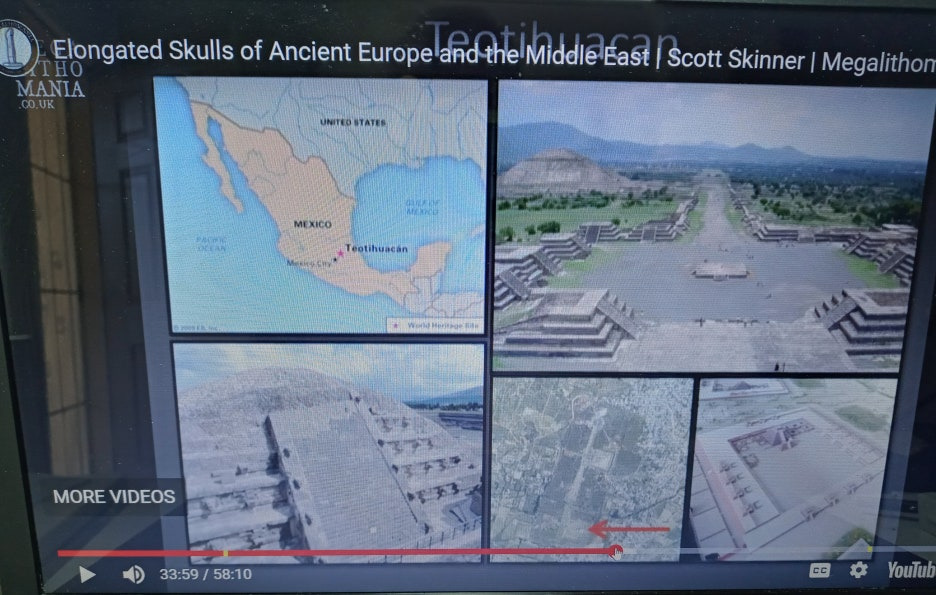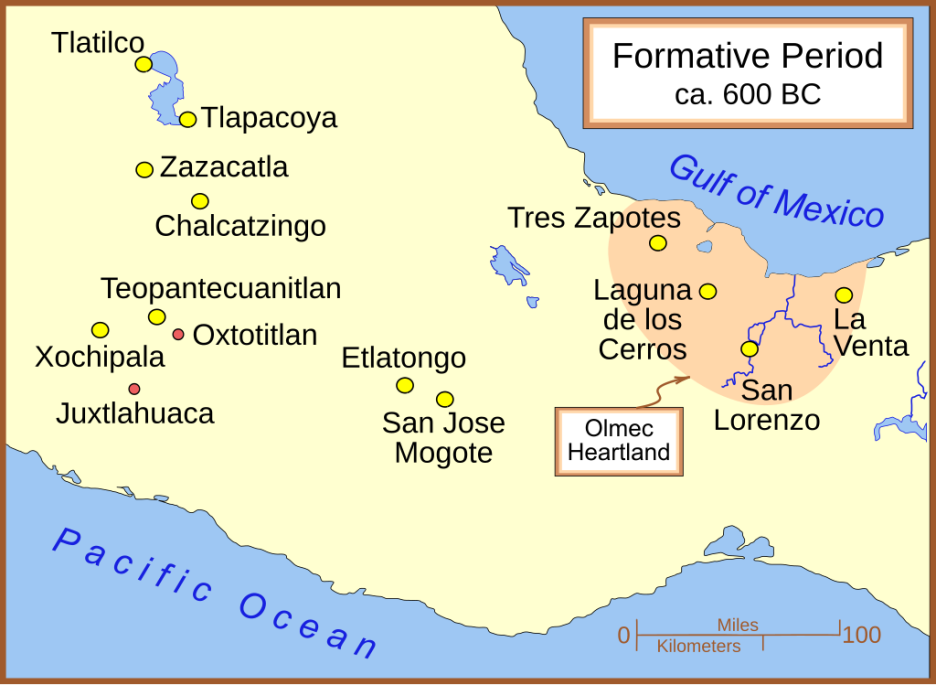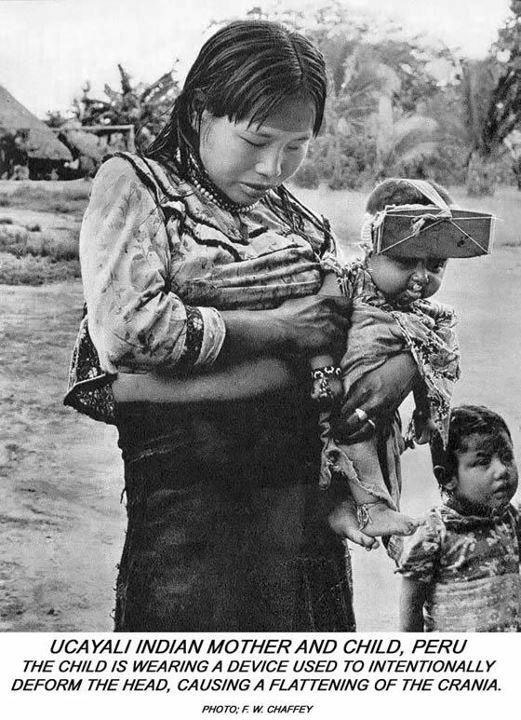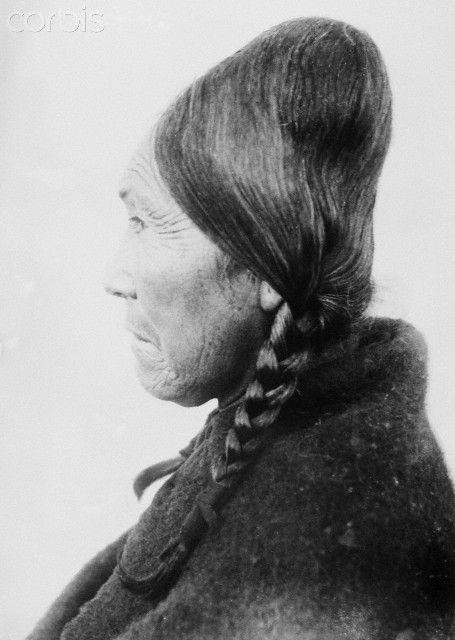
Worldwide distribution of skull modification practices.
J.Thomas, Author provided
(source : J. Thomas, Cranial deformation, Science Society, 인용출처; 본 블로그, 카테고리, 고대 종교 관습)
I. 아메리카지역에서의 편두

아메리카에서는 마야문명, 잉카문명에서 발견되는데, 마야문명에서는 특히 사회적 신분을 나타내는 것으로 인식되었다. 마야문명은 BC 2000년경 시작되었다. 즉 고조선 시대의 지역으로 고려할 수 있다.
북아메리카에서도 일부 서북지역, 동남지역 인디언들에서 이러한 관습이 발견되었다. (아래 자료 참조)
"In the Americas, the Maya,[17][18][19] Inca, and certain tribes of North American natives performed the custom. In North America the practice was known, especially among the Chinookan tribes of the Northwest and the Choctaw of the Southeast."
(source : Artificial Cranial Deformation, wikipedia)
I-1. 중앙아메리카
1) Mayans (BC 2000 - AD 1697)
"Across the Americas, in various tribes, infants had their heads bound and shaped by their parents. Both the Mayans and the Inca shaped their children’s skulls, as did the Choctaw and the Chinookan tribes in what is now the United States. Their reasons must have been the same, to allow for the child to fit into the fabric of their societies, and to signify class. For the Maya, it also held a religious significance.
According to Gonzalo Fernandez de Oviedo, a Spanish chronicler of the conquest of the Americas, a Mayan explained: “This is done because our ancestors were told by the gods that if our heads were thus formed we should appear noble …”
Two different styles of artificial cranial deformation were prevalent in Mayan culture, and indicated the wearer’s rank. Those who were destined (or hoped) to hold some position of high status, were given what is referred to as “oblique deformations,” which resulted in a high, pointed head shape. However, the general populace could only use an “erect deformation,” which led to a rounded skull shape, with flattening on the sides. Whether these shapes were in imitation of a jaguar’s skull, to show prowess, or in the shape of the maize god, to symbolise fertility, is a matter of debate among historians and archaeologists."
(source : Head Space: Behind 10,000 Years of Artificial Cranial
Modification, by Chris White May 26, 2015, 인용출처 : 본블로그,
카테고리, 고대종교 관습)

Various methods used by the Mayan people to shape a child's head

마야문명 위치 (자료 : 위키피디아)




2) Olmecs (BC 1200-BC 400)
The origin of cranial modification among the Maya is unknown, but it possibly was inherited from the Olmecs, predecessors of the Maya, who were located near the Tuxtla Mountains. Cranial modification was one of the most important practices of the Olmec culture.[12] Individuals enduring cranial modification could be of any status, but many more elite individuals were depicted with cranial modifications. Intentional deformation practices were used as a way to differentiate between members of the society.[4] All members of an elite family were expected to go through cranial modification, starting shortly after birth.[12] The procedure occurred while the skull of the child was not fully grown and still soft, making it easily shaped.
(source : Maya society, wikipedia, 인용출처: 본블로그, 카테고리, 아메리카)

올멕 문명 위치 (자료 : 위키피디아)
3) 아즈텍 문명
Cranial modification was a procedure that occurred when an individual was still young, usually during infancy because the cranial bones are still soft at this stage and capable of morphing. An infant would be bound between padded boards to cause a tabular effect in the growth of the skull. Another method was to wind a band tightly around the head for an annular effect. Both of these methods produced an elongated shape of the head.[2] This practice was seen as a desirable trait and often practiced in the upper classes.
(source : Aztec body modification, wikipedia, 인용출 처 : 본 블로그, 카테고리, 아메리카)

Aztec empire in 1519 (source : Wikipedia)
I-2. 남아메리카
1) 잉카 문명 (AD 1438-1533 AD)
The Inca practiced cranial deformation. They achieved this by wrapping tight cloth straps around the heads of newborns to alter the shape of their still-soft skulls. These deformations did not result in brain damage. Researchers at the Field Museum believe that the practice was used to mark different ethnicities across the Inca Empire.[36]
(source : Inca society, Wikipedia, 인용출처 : 본 블로그, 카테고리, 아메리카)

Inca Empire (최대 영토) (자료 : 위키피디아)




I-3. 북아메리카
1) Chinookan


Chinook child undergoing process of flattening the head.
The elite of some tribes had the practice of head binding, flattening their children's forehead and top of the skull as a mark of social status. They bound the infant's head under pressure between boards when the infant was about 3 months old and continued until the child was about one year of age.[12] This custom was a means of marking social hierarchy; flat-headed community members had a rank above those with round heads. Those with flattened skulls refused to enslave other persons who were similarly marked, thereby reinforcing the association of a round head with servility.[12] The Chinook were known colloquially by early white explorers in the region as "Flathead Indians".
(source : Chinookan peoples, wikipedia, 인용출처 : 본 블로그, 카테고리, 아메리카)

2) Choctaw
"Origins[edit]
One Choctaw origin story relates how in pre-historic times the Choctaw people lived in areas near and around what is now known as the Yucatan Peninsula. This story explains that when the original homeland of the Choctaw people became overcrowded many of them sailed across the sea to the land of present-day Alabama and Mississippi. (Caitlin, Letters and Notes, 1841) This origin in South America is supported by DNA evidence as well as the similarities between the beliefs, art, and customs of the people of the Southeastern Ceremonial Complex and the Indigenous peoples of South America.[7] Although the ancestral people of the Choctaw and other indigenous peoples in North America have participated in the evolution of their respective North American cultures for hundreds and even thousands of years, the Choctaw people as they are known today are believed to have coalesced during the 16th century, perhaps from peoples from Alabama and the Plaquemine cultures, and more anciently from indigenous peoples of South America................
The Choctaw people existed in a matrilineal kinship system, with children born into the iksa of their mother and the mother's iksa conferring her children's social status. Another tradition of this maternally oriented system was the role of the maternal uncle as an important figure in the lives of his sister's children. Maternal uncles acted as fathers and caretakers to the children of their sisters. The Choctaw people's adoration of woman and the Mother goddess was also reflected in their religious and spiritual reverence for the sacred mound of Nanih Waiya which is known as the "Mother Mound." Nanih Waiya is a great earthwork platform mound located in central-east Mississippi. This site remains a place of female pilgrimage for prayer, song, and dance to this day.
(source : Choctaw, wikipedia, 인용출처 : 본 블로그, 카테고리, 아메리카)
Family iksa[edit]

Choctaw Woman George Caitlin – 1834
Matrilineal organisation and kinship ties also dictated the family iksa or domestic sphere of relations.[7] Upon marriage, husbands joined their wives' households but were precluded as members of her clan or kinship network. Instead, he was considered a guest and not a direct relative.[9] In the event of separation, divorcee husbands would return to the iksa with which they carried a matrilineal connection, such as their sisters.[10]
(source : Iksas(Choctaw clans), wikipedia, 인용출처 :

3) Proto-Iroquoian
Proto-Iroquoian is the theoretical proto-language of the Iroquoian languages. Lounsbury (1961) estimated from glottochronology a time depth of 3,500 to 3,800 years for the split of North and South Iroquoian.
At the time of early European contact, French explorers in the 16th century encountered villages along the St. Lawrence River, now associated with the St. Lawrence Iroquoian. Other better known northern tribes took over their territory and displaced them, and were later encountered by more French, European and English colonists. These tribes included the Huron and Neutral in modern-day Ontario, first encountered by French explorers and traders; the Five Nations of the Iroquois League in Upstate New York and Pennsylvania, and the Erie Nation and Susquehannock peoples in Pennsylvania.
Southern speakers of Iroquoian languages ranged from the Cherokee in the Great Smoky Mountains, to the Tuscarora and Nottoway in the interior near the modern Virginia/North Carolina border.
(source : Proto-Iroquoian language, wikipedia, )
4) Cherokee
The Cherokee (/ˈtʃɛrəkiː, ˌtʃɛrəˈkiː/;[8][9] Cherokee: ᎠᏂᏴᏫᏯᎢ, romanized: Aniyvwiyaʔi or Anigiduwagi, or Cherokee: ᏣᎳᎩ, romanized: Tsalagi) people are one of the Indigenous peoples of the Southeastern Woodlands of the United States. Prior to the 18th century, they were concentrated in their homelands, in towns along river valleys of what is now southwestern North Carolina, southeastern Tennessee, southwestern Virginia, edges of western South Carolina, northern Georgia and northeastern Alabama consisting of around 40,000 square miles.[10]
The Cherokee language is part of the Iroquoian language group. In the 19th century, James Mooney, an early American ethnographer, recorded one oral tradition that told of the tribe having migrated south in ancient times from the Great Lakes region, where other Iroquoian peoples have been based.[11] However, anthropologist Thomas R. Whyte, writing in 2007, dated the split among the peoples as occurring earlier. He believes that the origin of the proto-Iroquoian language was likely the Appalachian region, and the split between Northern and Southern Iroquoian languages began 4,000 years ago.[12]
................
Marriage[edit]
Before the 19th century, polygamy was common among the Cherokee, especially by elite men.[89] The matrilineal culture meant that women controlled property, such as their dwellings, and their children were considered born into their mother's clan, where they gained hereditary status. Advancement to leadership positions was generally subject to approval by the women elders. In addition, the society was matrifocal; customarily, a married couple lived with or near the woman's family, so she could be aided by her female relatives. Her eldest brother was a more important mentor to her sons than was their father, who belonged to another clan. Traditionally, couples, particularly women, can divorce freely.[90]
.........
Gender roles[edit]
Men and women have historically played important yet, at times, different roles in Cherokee society. Historically, women have primarily been the heads of households, owning the home and the land, farmers of the family's land, and "mothers" of the clans. As in many Native American cultures, Cherokee women are honored as life-givers.[92] As givers and nurturers of life via childbirth and the growing of plants, and community leaders as clan mothers, women are traditionally community leaders in Cherokee communities. Some have served as warriors, both historically and in contemporary culture in military service. Cherokee women are regarded as tradition-keepers and responsible for cultural preservation.[93]
(source : Cherokee, wikipedia,

Pre-European contact distribution of the Iroquoian languages.

'한국사 > 공통' 카테고리의 다른 글
| 압록수 (요수)는 동아시아에 없었다 (1) | 2024.11.22 |
|---|---|
| 조르바 댄스는 과연 칼춤일까? (0) | 2023.09.22 |
| 바스크지역은 고조선 문명인가? (0) | 2023.09.14 |
| 당항성은 북아프리카에 있었나? (1) | 2023.06.18 |
| 후백제의 견훤이 공격한 강주(康州)(Kangju)는 이베리아 반도에 있지 않았을까? (1) | 2023.04.06 |